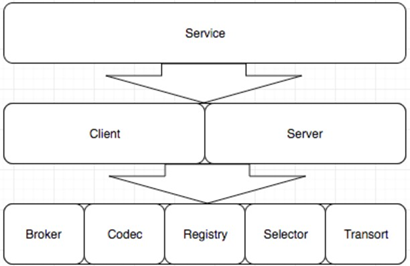一、go-micro入门
1. go-micro 简介
⚫ Go Micro 是一个插件化的基础框架,基于此可以构建微服务,Micro 的设计哲学是可插拔的插件化架构
⚫ 在架构之外,它默认实现了 consul 作为服务发现(2019 年源码修改了默认使用mdns),通过 http 进行通信,通过 protobuf 和 json 进行编解码
2. go-micro 的主要功能
⚫ 服务发现:自动服务注册和名称解析。服务发现是微服务开发的核心。当服务 A需要与服务 B 通话时,它需要该服务的位置。默认发现机制是多播 DNS(mdns),一种零配置系统。您可以选择使用 SWIM 协议为 p2p 网络设置八卦,或者为弹性云原生设置设置 consul
⚫ 负载均衡:基于服务发现构建的客户端负载均衡。一旦我们获得了服务的任意数量实例的地址,我们现在需要一种方法来决定要路由到哪个节点。我们使用随机散列负载均衡来提供跨服务的均匀分布,并在出现问题时重试不同的节点
⚫ 消息编码:基于内容类型的动态消息编码。客户端和服务器将使用编解码器和内容类型为您无缝编码和解码 Go 类型。可以编码任何种类的消息并从不同的客户端发送。客户端和服务器默认处理此问题。这包括默认的protobuf 和 json
⚫ 请求/响应:基于 RPC 的请求/响应,支持双向流。我们提供了同步通信的抽象。对服务的请求将自动解决,负载平衡,拨号和流式传输。启用 tls 时,默认传输为 http/ 1.1 或 http2
⚫ Async Messaging:PubSub 是异步通信和事件驱动架构的一流公民。事件通知是微服务开发的核心模式。启用 tls 时,默认消息传递是点对点 http / 1.1 或 http2
⚫ 可插拔接口:Go Micro 为每个分布式系统抽象使用 Go 接口,因此,这些接口是可插拔的,并允许 Go Micro 与运行时无关,可以插入任何基础技术
◼ 插件地址:https://github.com/micro/go-plugins
3. go-micro 通信流程
⚫ Server 监听客户端的调用,和 Brocker 推送过来的信息进行处理。并且 Server 端需要向 Register 注册自己的存在或消亡,这样 Client 才能知道自己的状态
⚫ Register 服务的注册的发现,Client 端从 Register 中得到 Server 的信息,然后每次调用都根据算法选择一个的 Server 进行通信,当然通信是要经过编码/解码,选择传输协议等一系列过程的
⚫ 如果有需要通知所有的 Server 端可以使用 Brocker 进行信息的推送,Brocker 信息队列进行信息的接收和发布
4. go-micro 核心接口
⚫ go-micro 之所以可以高度订制和他的框架结构是分不开的,go-micro 由 8 个关键的interface 组成,每一个 interface 都可以根据自己的需求重新实现,这 8 个主要的inteface 也构成了 go-micro 的框架结构

二、Go Micro接口详解
1. Transort 通信接口
⚫ 服务之间通信的接口,也就是服务发送和接收的最终实现方式,是由这些接口定制的
type Socket interface {
Recv(*Message) error
Send(*Message) error
Close() error
}
type Client interface {
Socket
}
type Listener interface {
Addr() string
Close() error
Accept(func(Socket)) error
}
type Transport interface {
Dial(addr string, opts ...DialOption) (Client, error)
Listen(addr string, opts ...ListenOption) (Listener, error)
String() string
}
2. Codec 编码接口
⚫ go-micro 有很多种编码解码方式,默认的实现方式是protobuf,当然也有其他的实现方式,json
type Codec interface {
ReadHeader(*Message, MessageType) error
ReadBody(interface{}) error
Write(*Message, interface{}) error
Close() error
String() string
}
3. Registry 注册接口
⚫ 服务的注册和发现,目前实现的有 consul、mdns、etcd、zookeeper、kubernetes 等
type Registry interface {
Register(*Service, ...RegisterOption) error
Deregister(*Service) error
GetService(string) ([]*Service, error)
ListServices() ([]*Service, error)
Watch(...WatchOption) (Watcher, error)
String() string
Options() Options
}
4. Selector 负载均衡
⚫ 以 Registry 为基础,Selector 是客户端级别的负载均衡,当有客户端向服务发送请求时,selector 根据不同的算法从 Registery 中的主机列表,得到可用的 Service 节点,进行通信,目前实现的有循环算法和随机算法,默认的是随机算法
type Selector interface {
Init(opts ...Option) error
Options() Options
// Select returns a function which should return the next node
Select(service string, opts ...SelectOption) (Next, error)
// Mark sets the success/error against a node
Mark(service string, node *registry.Node, err error)
// Reset returns state back to zero for a service
Reset(service string)
// Close renders the selector unusable
Close() error
// Name of the selector
String() string
}
5. Broker 发布订阅接口
⚫ Broker 是消息发布和订阅的接口。例如,因为服务的节点是不固定的,如果需要修改所有服务行为,可以使服务订阅某个主题,当有信息发布时,所有的监听服务都会收到信息,根据你的需要做相应的行为即可
type Broker interface {
Options() Options
Address() string
Connect() error
Disconnect() error
Init(...Option) error
Publish(string, *Message, ...PublishOption) error
Subscribe(string, Handler, ...SubscribeOption) (Subscriber, error)
String() string
}
6. Client 客户端接口
⚫ Client 是请求服务的接口,他封装Transport 和Codec 进行rpc 调用,也封装了Brocker进行信息的发布
type Client interface {
Init(...Option) error
Options() Options
NewMessage(topic string, msg interface{}, opts ...MessageOption) Message
NewRequest(service, method string, req interface{}, reqOpts ...RequestOption) Request
Call(ctx context.Context, req Request, rsp interface{}, opts ...CallOption) error
Stream(ctx context.Context, req Request, opts ...CallOption) (Stream, error)
Publish(ctx context.Context, msg Message, opts ...PublishOption) error
String() string
}
7. Server 服务端接口
⚫ Server 监听等待 rpc 请求,监听 broker 的订阅信息,等待信息队列的推送等
type Server interface {
Options() Options
Init(...Option) error
Handle(Handler) error
NewHandler(interface{}, ...HandlerOption) Handler
NewSubscriber(string, interface{}, ...SubscriberOption) Subscriber
Subscribe(Subscriber) error
Register() error
Deregister() error
Start() error
Stop() error
String() string
}
8. Serveice 接口
⚫ Service 是 Client 和 Server 的封装,他包含了一系列的方法使用初始值去初始化
type Service interface {
Init(...Option)
Options() Options
Client() client.Client
Server() server.Server
Run() error
String() string
}